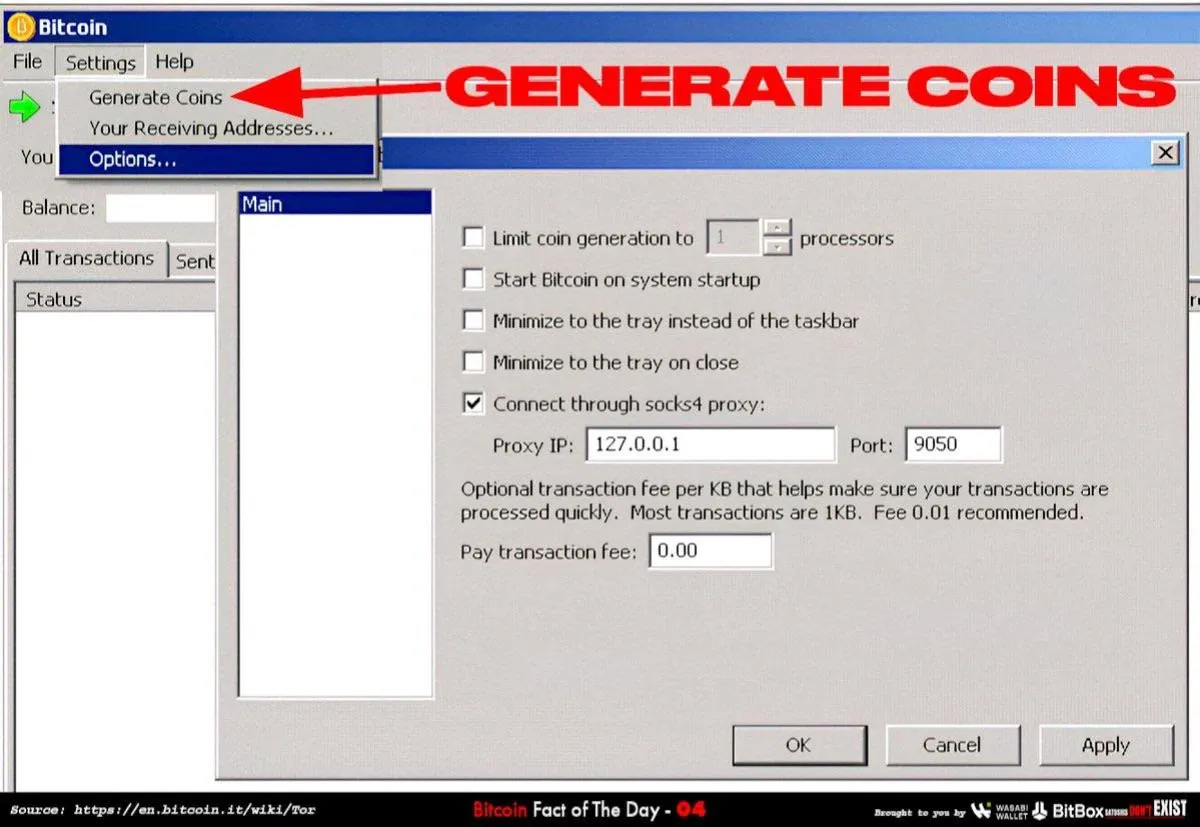GENERATE COINS
December 12, 2009
1BTC:$0.000640
- Artist
- Fact Date
- Fact #
- undefined
- Printing Specifications
- Paper / Stock
- Page Size
Bitcoins are mined by performing billions of computationally intensive calculations per second to solve a complex math problem. If you tried to mine bitcoin with your PC today, it would take years. But in 2009, that’s how it was done. Back then, the mining difficulty was much lower and there were fewer miners competing, making the humble PC perfect for the job.
The term “Bitcoin mining” elicits images of high-performance hardware whirring away in supercooled data centres. But back near the start, that’s not how it was done. To mine coins, you could simply connect your laptop to the Bitcoin network and it would mine in the background, generating a few dozen coins per day if you were lucky.
Moreover, contrary to popular belief, participating in mining at this time did not require a high degree of technical knowledge. That’s because the very first Bitcoin wallet, developed by Satoshi Nakamoto, allowed anyone to start mining in a couple of clicks. The first build of Bitcoin-Qt, as the wallet was known, contained a readme.txt file composed by Satoshi that explained how mining worked and how to participate.
It read: “To support the network by running a node, select: “Options->Generate Coins” and keep the program open or minimized. It runs at idle priority when no other programs are using the CPU. Your computer will be solving a very difficult computational problem that is used to lock in blocks of transactions. The time to generate a block varies each time, but may take days or months, depending on the speed of your computer and the competition on the network.”
Significantly, Satoshi didn’t use the word “mining,” which is also conspicuously absent from the Bitcoin whitepaper. Instead, he referred to the process as “generating” – and anyone could start generating their own coins by running their desktop computer with this option enabled in Bitcoin-Qt. This was free money – albeit money that had virtually zero value at that point in time.
Much of the “zero value” coins that were mined in the first 18 months of Bitcoin’s existence, incidentally, are believed to have been found by Satoshi himself. Sergio Demian Lerner is the researcher who identified a distinct mining fingerprint indicating that a single entity, believed to be Satoshi, mined around 1.1 million BTC from 2009–2010. In his view, “It is uncertain whether Bitcoin could have succeeded without Satoshi’s concentrated mining. Early on, the network was highly vulnerable to attacks. Malicious actors could have attempted to reorganise the blockchain or disrupt the network simply to demonstrate its failure.
“Given these risks, it’s highly probable that Satoshi’s early control over the network’s hash rate was essential for Bitcoin’s survival. Satoshi gradually reduced his mining efforts and allowed independent miners to contribute once the network’s security was stable, demonstrating his intention to decentralise Bitcoin at the right time. This strategic move ensured the network could evolve without the risks of centralisation.”
Idle Mining
He may have claimed the lion’s share of coins in the early years, but Satoshi wasn’t selfish. Not only did Bitcoin’s founder enable users to mine coins using their personal computer, but he actively encouraged them to do so, recognising that this was an effective way to bootstrap the network. His readme.txt continued: “It’s not a computation that has to start over from the beginning if you stop and restart it. A solution might be found at any given moment it’s running. As a reward for supporting the network, you receive coins when you successfully generate a block.”
This capability was built into the Bitcoin-Qt wallet from its very first release in February 2009. As late as November 2009, it was still feasible to mine BTC using the Generate Coins option, as evidenced by a forum post Satoshi made on the topic around this time.

For the first year of Bitcoin’s existence, wallet users possessed the ability to passively mine thousands of BTC, before increasing network difficulty rendered this impractical. Despite this fact, it’s believed that very few individuals took advantage of this capability. Many users didn’t even realise the feature was there, tucked away inside the Bitcoin-Qt wallet, while others merely experimented with Generate Coins and then got bored.
As one BitcoinTalk forum user remarked, returning to Satoshi’s November 2009 thread years later, “Remember when [mining BTC] was as easy as "click generate?" Even then, very few people did, and often those that did, like myself, didn't do it for very long.”
Not only did Satoshi create peer-to-peer digital cash, but he provided a fair way for anyone to claim it.
- Artist
- XXXXX
- BTC On this day
- December 12, 2009
- Market Cap
- $944
- Block Number
- 25,599
- Hash Rate
- undefined TH/s
- Price Change (1M)
52%
- Price Change (3M)
0%
- Price Change (1Y)
0%
